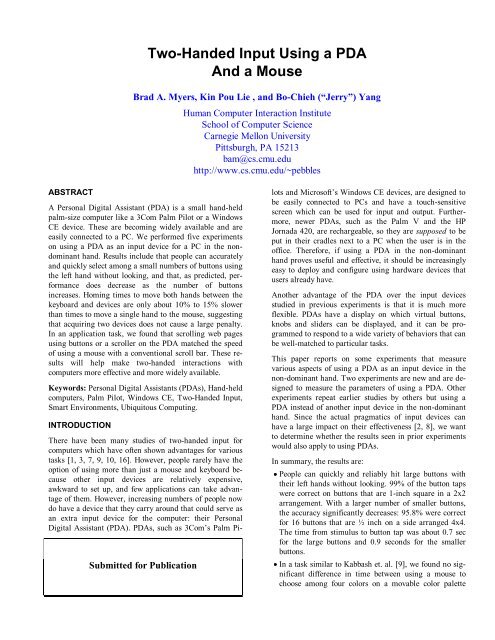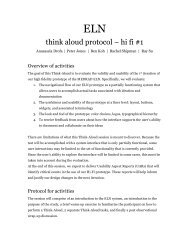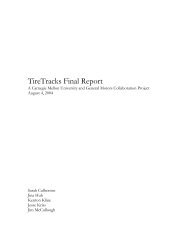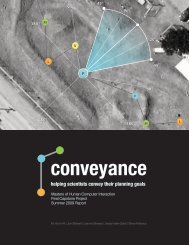Two-Handed Input Using a PDA And a Mouse - Carnegie Mellon ...
Two-Handed Input Using a PDA And a Mouse - Carnegie Mellon ...
Two-Handed Input Using a PDA And a Mouse - Carnegie Mellon ...
- No tags were found...
Create successful ePaper yourself
Turn your PDF publications into a flip-book with our unique Google optimized e-Paper software.
<strong>Two</strong>-<strong>Handed</strong> <strong>Input</strong> <strong>Using</strong> a <strong>PDA</strong><strong>And</strong> a <strong>Mouse</strong>Brad A. Myers, Kin Pou Lie , and Bo-Chieh (“Jerry”) YangHuman Computer Interaction InstituteSchool of Computer Science<strong>Carnegie</strong> <strong>Mellon</strong> UniversityPittsburgh, PA 15213bam@cs.cmu.eduhttp://www.cs.cmu.edu/~pebblesABSTRACTA Personal Digital Assistant (<strong>PDA</strong>) is a small hand-heldpalm-size computer like a 3Com Palm Pilot or a WindowsCE device. These are becoming widely available and areeasily connected to a PC. We performed five experimentson using a <strong>PDA</strong> as an input device for a PC in the nondominanthand. Results include that people can accuratelyand quickly select among a small numbers of buttons usingthe left hand without looking, and that, as predicted, performancedoes decrease as the number of buttonsincreases. Homing times to move both hands between thekeyboard and devices are only about 10% to 15% slowerthan times to move a single hand to the mouse, suggestingthat acquiring two devices does not cause a large penalty.In an application task, we found that scrolling web pagesusing buttons or a scroller on the <strong>PDA</strong> matched the speedof using a mouse with a conventional scroll bar. These resultswill help make two-handed interactions withcomputers more effective and more widely available.Keywords: Personal Digital Assistants (<strong>PDA</strong>s), Hand-heldcomputers, Palm Pilot, Windows CE, <strong>Two</strong>-<strong>Handed</strong> <strong>Input</strong>,Smart Environments, Ubiquitous Computing.INTRODUCTIONSubmitted for PublicationThere have been many studies of two-handed input forcomputers which have often shown advantages for varioustasks [1, 3, 7, 9, 10, 16]. However, people rarely have theoption of using more than just a mouse and keyboard becauseother input devices are relatively expensive,awkward to set up, and few applications can take advantageof them. However, increasing numbers of people nowdo have a device that they carry around that could serve asan extra input device for the computer: their PersonalDigital Assistant (<strong>PDA</strong>). <strong>PDA</strong>s, such as 3Com’s Palm Pilotsand Microsoft’s Windows CE devices, are designed tobe easily connected to PCs and have a touch-sensitivescreen which can be used for input and output. Furthermore,newer <strong>PDA</strong>s, such as the Palm V and the HPJornada 420, are rechargeable, so they are supposed to beput in their cradles next to a PC when the user is in theoffice. Therefore, if using a <strong>PDA</strong> in the non-dominanthand proves useful and effective, it should be increasinglyeasy to deploy and configure using hardware devices thatusers already have.Another advantage of the <strong>PDA</strong> over the input devicesstudied in previous experiments is that it is much moreflexible. <strong>PDA</strong>s have a display on which virtual buttons,knobs and sliders can be displayed, and it can be programmedto respond to a wide variety of behaviors that canbe well-matched to particular tasks.This paper reports on some experiments that measurevarious aspects of using a <strong>PDA</strong> as an input device in thenon-dominant hand. <strong>Two</strong> experiments are new and are designedto measure the parameters of using a <strong>PDA</strong>. Otherexperiments repeat earlier studies by others but using a<strong>PDA</strong> instead of another input device in the non-dominanthand. Since the actual pragmatics of input devices canhave a large impact on their effectiveness [2, 8], we wantto determine whether the results seen in prior experimentswould also apply to using <strong>PDA</strong>s.In summary, the results are:x People can quickly and reliably hit large buttons withtheir left hands without looking. 99% of the button tapswere correct on buttons that are 1-inch square in a 2x2arrangement. With a larger number of smaller buttons,the accuracy significantly decreases: 95.8% were correctfor 16 buttons that are ½ inch on a side arranged 4x4.The time from stimulus to button tap was about 0.7 secfor the large buttons and 0.9 seconds for the smallerbuttons.x In a task similar to Kabbash et. al. [9], we found no significantdifference in time between using a mouse tochoose among four colors on a movable color palette
<strong>Two</strong>-<strong>Handed</strong> <strong>Input</strong> <strong>Using</strong> a <strong>PDA</strong> <strong>And</strong> a <strong>Mouse</strong> - 2 - ** SUBMITTED FOR PUBLICATION**compared to using the left hand to choose among fourbuttons on the <strong>PDA</strong>. Kabbash reported similar results onleft-hand use.x In a task where the subjects had to move both handsfrom the keyboard to the <strong>PDA</strong> and the mouse and thenback, we found that it took about 0.791 seconds to moveboth hands from the devices to the keyboard. This wasabout 13% slower than moving one hand from themouse to the keyboard (which took 0.701 sec). Movingto a <strong>PDA</strong> and mouse from the keyboard took about 0.838seconds, which is about 15% slower than moving onehand to the mouse (0.728 seconds).x In a repeat of the experiment reported in [16], subjectswere able to scroll large web pages and then select a linkon the page at about the same speed using buttons or ascroller on a <strong>PDA</strong> compared to using the mouse with aconventional scroll bar.RELATED WORKThere have been many studies of using input devices forcomputers in both hands, but none have tested <strong>PDA</strong>s in theleft hand, and we were unable to find measurements ofhoming times from the keyboard to devices for two-handeduse.One of the earliest experiments measured the use of twohands in a positioning and scaling task and for scrolling toknown parts of a document [3]. This study found that peoplenaturally adopted parallel use of both hands and couldscroll faster with the left hand. Theoretical studies showthat people naturally assign different tasks to each hand,and that the non-dominant hand can support the task ofthe dominant hand [6]. This has motivated two-handedinterfaces where the non-dominant hand plays a supportingrole, such as moving a palette [9], controlling otherdrawing tools [10], and adjusting translation and scaling[3, 16]. Other studies have tested two-handed use for 3Dinteraction [1, 7] and found the extra input to be useful.There has been prior work on using <strong>PDA</strong>s at the same timeas regular computers for various tasks including meetingsupport [12], sharing information [13], and to help individualsat their desks [11], but no prior work on measuringperformance of non-dominant hand use of <strong>PDA</strong>s.EXPERIMENTAL DESIGNOur new studies were performed in two phases. In the firstphase, the subjects did five tasks in a row. The first taskwas a typing test to see how fast the subjects could type.Second, they performed a button size task to measure theerror rates and speeds when tapping on different size buttonson the <strong>PDA</strong>. Third, subjects selected colors from apalette using either the <strong>PDA</strong> or the mouse, which is similarto an earlier experiment [9]. Unfortunately, thisexperiment provided no statistically significant differencesin performance of the mouse and <strong>PDA</strong> conditions, and willnot be further discussed here due to lack of space. Fourth,the subjects performed a homing speed task where wemeasured the speed with which the subjects moved amongthe keyboard and the devices. Fifth, they performed ascrolling task using a variety of devices, which is a repeatof an earlier experiment [16]. The subjects reported anumber of problems with the scrolling devices on the <strong>PDA</strong>in the fifth task, so we redesigned the scrolling devices,and in a separate phase with new subjects, we studied theperformance of the new scrollers on the same task. Each ofthese studies is described in detail next.ApparatusSubjects sat at a normal PC desktop computer that wasrunning Windows NT. On the right of the keyboard was amouse on a mouse pad. On the left was an IBM WorkPad8602-30X <strong>PDA</strong> (which is the same as a Palm IIIx). In thefirst phase, we put the WorkPad in its cradle. Subjectscomplained that the WorkPad was wobbly it its cradle, sofor the second phase, the new subjects used a WorkPadresting on a book and connected by a serial cable to thePC. There were no further comments about the positioning.The WorkPad has a 3¼-inch diagonal LCD display screen(about 2 ¼ inches on a side) which is touch sensitive. It is160x160 pixels. Figure 1 shows a picture of the full Work-Pad.The software running on the WorkPad was the Shortcutterprogram [11] that allows panels of controls to be created sothat each control sends specified events to the PC. Thesoftware on the PC was various applications specificallycreated for this experiment (except in the scrolling task,which used the Netscape browser running a customJavaScript program to collect the data).Typing TestWe used a computerized typing test called “Speed TypingTest 1.0” [15]. The subjects were asked to type a paragraphdisplayed on the screen as fast as possible.Button Size TaskIn this task, the <strong>PDA</strong> displayed between 4 and 16 buttonsin eight different arrangements: 2 rows by 2 columns, 2x3,3x2, 2x4, 4x2, 3x4, 4x3, and 4x4 (see Figure 1). To controlfor ordering effects, half of the subjects used the ordershown above, and the other half used the reverse order(4x4 first down to 2x2 last). In the 2x2 condition, the buttonswere about one inch square, and in the 4x4, they wereabout ½ inch square.At the beginning of each condition, a picture was displayedon the PC screen showing the corresponding layoutof the buttons (at the same size as the <strong>PDA</strong>). Then one ofthe buttons was shaded black (see Figure 2). The subjectswere asked to tap on the corresponding button on the
<strong>Two</strong>-<strong>Handed</strong> <strong>Input</strong> <strong>Using</strong> a <strong>PDA</strong> <strong>And</strong> a <strong>Mouse</strong> - 4 - ** SUBMITTED FOR PUBLICATION**moving the finger further from the start point scrolledfaster.The order of the conditions was varied across subjects.Revised Scrolling Task(a) (b) (c)Figure 3. (a) The button scroller on the WorkPad used in thefirst experiment. (b) The Slide Scroller and (c) Rate scroller usedin both experiments.(a)(b)Figure 4. (a) The revised button scroller on the WorkPad used inthe second experiment. (b) The “absolute scroller”.The condition with the fastest time in the previous experimentused a “pointing stick” joystick to scroll, but we werenot able to reproduce this condition.4 The conditions weused in our first experiment were:x Scrolling using the mouse and the regular scroll bar.x Scrolling using a “scroll wheel” mounted in the centerof the mouse (a Microsoft “Intelli<strong>Mouse</strong>”). We werecareful to explain to the subjects the three different waysthe wheel can be used, including rolling the wheel, ortapping or holding the wheel down to go into “scrollmode” where the further you move the mouse from thetap point, the faster the text scrolls.x Scrolling using buttons on the WorkPad (see Figure 3a).There were 6 buttons that scrolled up and down a line,up and down a page, and left and right (which were notneeded for this experiment). The buttons auto-repeatedif held down.x Scrolling using a “slider” on the WorkPad (see Figure3b). Putting a finger on the slider and moving up ordown moved the text the corresponding amount. Therefore,it was as if a line of text on the screen was attachedto your finger.x Scrolling using a “rate scroller,” which acted like a ratecontrolledjoystick with three speeds (see Figure 3c).Putting a finger on the WorkPad and moving up ordown started the text moving in that direction, and4 We did have a pointing stick to test, and anyway, it would have been difficultto connect one to the computers we had, which illustrates one of theclaims of this paper—it can be difficult to connect multiple conventionalinput devices to today’s computers. Since the experimental set up was identicalto the original experiment [16], it should be valid to compare our timeswith the times reported there.We received a number of complaints and suggestions aboutthe scrollers on the WorkPad in the first session, so we redesignedsome of them and repeated the scrolling task in aseparate experiment with new subjects. In this session, weonly used four buttons for the button scroller (since the leftand right buttons were not needed—see Figure 4a). We alsotried to improve the rate scroller, by adjusting the scrollspeeds and the areas where each speed was in affect. Finally,we added a new (sixth) condition:x Scrolling using an “absolute scroller,” where the lengthof the scroller represented the entire document, so puttinga finger at the top jumped to the top of thedocument, and the bottom represented the bottom (seeFigure 4b). The user could also drag up and down toscroll continuously. Therefore, it was as if the scrollbar’s indicator was attached to the finger. The motivationfor this scroller was that we noticed that mostpeople in the mouse condition of the first sessiondragged the indicator of the scroll bar up and down, andwe wanted to provide an equivalent WorkPad scroller.SubjectsThere were 12 subjects who did all five tasks in the firstphase, which took about an hour and they were paid $15for participating. 12 different subjects did the last phase,which took about ½ hour and they were paid $10. All subjectswere <strong>Carnegie</strong> <strong>Mellon</strong> University students, faculty, orstaff. 25% (6 out of 24) were female, and the age rangedfrom 19 to 46 with a median of 26. All were moderately tohighly proficient with computers, and half had used <strong>PDA</strong>s.The data from some extra subjects were eliminated due totechnical difficulties or because the subjects were lefthanded.RESULTSGeneralPearson product-moment correlation coefficient betweentyping speed and tap speed in the button size task (namelythe mean tap speed across all 8 layouts) was .60, whichmeans the faster typists were somewhat faster at tapping.The correlation coefficient between typing speed andscrolling speed (in the revised scrolling task) across all 6conditions and both trials was 0.32, which means therewas less correlation for the scrolling task.Age and gender did not affect the measures. The measuresfrom two extra subjects who were left-handed are not includedin the data, but informally, their numbers did notlook different.
<strong>Two</strong>-<strong>Handed</strong> <strong>Input</strong> <strong>Using</strong> a <strong>PDA</strong> <strong>And</strong> a <strong>Mouse</strong> - 7 - ** SUBMITTED FOR PUBLICATION**DISCUSSIONButton SizeThe subjects were able to hit buttons quite accurately withtheir left hand, especially for small numbers of buttons.The predicted decrease in performance with button sizewas observed. There seems to be a threshold of about 8buttons before there is any affect of the size.We believe that we achieved expert performance (thelearning curve flattened out) by the end of the experiment,so we tried using the times in models of expert humanperformance. One candidate is Fitts’s law, but we do notknow exactly where the subjects’ fingers were when theystarted to move to tap. Assuming a movement of about 2inches and a target size of 1 inch (in the 2x2 case), Fitts’slaw as formulated in [5, p. 55] predicts a movement timeof about 150msec, compared to our measurement of593msec. In our task, however, there is also perceptionand thinking time. For the smaller buttons (½ inch in the16x16 case), Fitts’s law predicts an increase in time ofabout 100msec, but we saw an increase of about 275msec.We observed that subjects looked back and forth from themonitor to the <strong>PDA</strong>, at an increasing rate depending onthe number of buttons to choose from. Therefore, we believethe performance cannot be modeled simply as aFitts’s law task, but we were unable to find an appropriatealternative model.Our results showing that users can tap up to 8 buttons accuratelyand quickly with the left hand is relevant sincethere are a number of applications where having a fewbuttons on the <strong>PDA</strong> would be useful. Examples includescrolling with buttons (Figure 3a and Figure 4a), and panelscreated with the Shortcutter tool for controlling a compiler,playing music on the PC, reading mail, etc. [11].Homing TimesOur one-handed homing time to move from the mouse tothe keyboard (701 msec – see Figure 9) is longer than thetime to move from the <strong>PDA</strong> to the keyboard (639 msec).This may be because the physical distance to the mousefrom the home position on the keyboard is longer (14inches compared to 7 inches) due to the number-pad andarrow keys sections of the PC keyboard. In the other direction,the increased time to acquire the <strong>PDA</strong> may be due tothe unfamiliarity of homing to this kind of device.In the classic study of text selection devices [5, p. 237], thehoming time to move from the space bar to the mouse wasmeasured as 0.36 seconds. This was measured fromvideotapes of subjects moving. An average homing time of0.4 seconds was incorporated into the Keystroke LevelModel [4]. However, we measured one-handed homingtimes of around 0.7 seconds, which is substantially longer.Our time was measured from the time of the mouse clickto the time that the first keystroke was recognized. Ourtyping test shows that the average time per keystroke was0.3 seconds, so this might be subtracted from our measuredtime to get the predicted 0.4 seconds.An important observation is that, as predicted, subjectsmoved both hands simultaneously, and this did not penalizethe movement time much. The sum of the one-handedtimes to move from mouse and <strong>PDA</strong> to the keyboard is1340msec (701+639). This is much larger than the time tomove from both mouse and <strong>PDA</strong> to the keyboard in thetwo handed case which is 791 msec (1340msec is 69%larger). A similar relationship holds for the movementfrom the keyboard to the <strong>PDA</strong> and mouse(728+7443=1473 > 838; 76% larger).Overall, it takes only about 15% longer to acquire both themouse and the <strong>PDA</strong> than just to acquire the mouse, and ittakes only about 13% longer to get back to the keyboardfrom both devices than from just the mouse.We were not able to find any prior studies of the time toacquire two devices at the same time. Most studies of twohandeduse of input devices (including our button-size andscrolling tasks) allow the subjects to stay homed on the devices.We found that moving both hands slowed down eachhand a little, but there was substantial parallel movement.Realistic tasks are likely to include a mix of keyboard andother input device use, so homing issues may be important.ScrollingOur measured times for scrolling the web pages with themouse (about 60 seconds) is a little faster than the timereported in [16], but our fastest time with any device doesnot beat the time reported in that paper for scrolling withthe in-keyboard isometric joystick. An interesting comparisonis between their joystick, our Rate Scroller (Figure3c) and the scroll wheel used in its most popular manneras a rate-controlled scroller. All provide the same ratecontrolledstyle of scrolling, but they have significantlydifferent performances and ratings by users. Our attempt toimprove the rate scroller obviously did not help, showingthat further work is needed to make this scrolling methodeffective. We observed that the fast speed was much toofast, but the medium speed was too slow. The popularity ofthe scroll wheel and the success of the pointing stick giveus reason to keep trying. Furthermore, IBM did significantexperimentation and adjustments before the pointing stickhad acceptable performance [14]. Therefore, an importantconclusion from the scrolling study is that the specific designand pragmatics of the input methods has a veryimportant influence on the performance.We were encouraged that the times for the button scrollerand absolute scroller were so close to the mouse, and webelieve these can be further improved through iterative design.Another interesting result is that our subjects quite likedthe scroll wheel (average rating of 1.7 | very good),
<strong>Two</strong>-<strong>Handed</strong> <strong>Input</strong> <strong>Using</strong> a <strong>PDA</strong> <strong>And</strong> a <strong>Mouse</strong> - 8 - ** SUBMITTED FOR PUBLICATION**whereas in the earlier study it was rated much worse (-1 |poor) [16]. This may be due to the increased experiencepeople have with a scroll wheel (many of our subjects havea scroll wheel on their own mouse), and because most ofour subjects used it in its rate-controlled joystick mode,whereas most of the earlier study’s subjects used the rollingmode.An interesting observation about this Web scrolling task ingeneral is that it primarily tests scrolling while searchingfor information, so the scrolling must go slow enough sothe subjects can see the content go by. This is why themethods that provided the best control over the speed arepreferred. The low rating of the rate scroller on the <strong>PDA</strong> isbecause the fastest speed was much too fast to see the textgo by, and the medium and slow speeds were rated as tooslow. However, other scrolling tasks, such as those testedby [3], require the user to go to a known place in thedocument, and then a method that can move long distancesvery quickly may be desirable.CONCLUSIONSAlthough it is interesting to study custom devices for useby the non-dominant hand, in order for there to be widescale use, it is better to provide mechanisms that users caneasily get and configure. Since increasing numbers of peoplehave <strong>PDA</strong>s that are easy to connect to PCs, it makessense to see if <strong>PDA</strong>s can be used effectively in the nondominanthand. The research presented here shows that<strong>PDA</strong>s can be used as buttons and scrollers, and that thetime to home to two devices is only slightly longer than forone. Since the <strong>PDA</strong> can be programmed with a variety ofcontrols with various properties, further research is warrantedto determine the most effective ways that a <strong>PDA</strong>can be used to control the PC in both the dominant andnon-dominant hand.ACKNOWLEDGMENTSFor help with this paper, we would like to thank **Shumin Zhai****.The research reported here is supported by grants from DARPA,Microsoft, IBM and 3Com. This research was performed in partin connection with Contract number DAAD17-99-C-0061 withthe U.S. Army Research Laboratory. The views and conclusionscontained in this document are those of the authors and shouldnot be interpreted as presenting the official policies or position,either expressed or implied, of the U.S. Army Research Laboratoryor the U.S. Government unless so designated by otherauthorized documents. Citation of manufacturer’s or trade namesdoes not constitute an official endorsement or approval of the usethereof.2. Buxton, W., “Lexical and Pragmatic Considerations of <strong>Input</strong>Structures.” Computer Graphics, 1983. 17(1) pp. 31-37.3. Buxton, W. and Myers, B. “A Study in <strong>Two</strong>-<strong>Handed</strong> <strong>Input</strong>,” inProceedings SIGCHI'86: Human Factors in Computing Systems.1986. Boston, MA: pp. 321-326.4. Card, S.K., Moran, T.P., and Newell, A., “The Keystroke-Level Model for User Performance Time with Interactive Systems.”Communications of the ACM, 1980. 23(7) pp. 396-410.July.5. Card, S.K., Moran, T.P., and Newell, A., The Psychology ofHuman-Computer Interaction. 1983, Hillsdale, NJ: LawrenceErlbaum Associates.6. Guiard, Y., “Asymmetric Divison of Labor in Human SkilledBimanual Action: The Kinematic Chain as a Model.” Journal ofMotor Behavior, 1987. 19(4) pp. 486-517.7. Hinckley, K., et al., “<strong>Two</strong>-<strong>Handed</strong> Virtual Manipulation.”ACM Transactions on Computer Human Interaction, 1998. 5(3)pp. 260-302. Sept.8. Jacob, R.J.K., et al., “Integrality and Separability of <strong>Input</strong> Devices.”ACM Transactions on Computer-Human Interaction,1994. 1(1) pp. 3-26.9. Kabbash, P., Buxton, W., and Sellen, A. “<strong>Two</strong>-<strong>Handed</strong> <strong>Input</strong>in a Compound Task,” in Proceedings SIGCHI'94: HumanFactors in Computing Systems. 1994. Boston, MA: pp. 417-423.10. Kurtenbach, G., et al. “The Design of a GUI Paradigm basedon Tablets, <strong>Two</strong>-hands, and Transparency,” in Proceedings,CHI'97: Human Factors in Computing Systems. 1997. Atlanta,GA: ACM. pp. 35-42.11. Myers, B.A., et al., “Individual Use of Hand-Held andDesktop Computers Simultaneously,” 1999. Submitted for Publication.12. Myers, B.A., Stiel, H., and Gargiulo, R. “Collaboration <strong>Using</strong>Multiple <strong>PDA</strong>s Connected to a PC,” in ProceedingsCSCW'98: ACM Conference on Computer-Supported CooperativeWork. 1998. Seattle, WA: pp. 285-294.13. Rekimoto, J. “A Multiple Device Approach for SupportingWhiteboard-based Interactions,” in Proceedings SIGCHI'98:Human Factors in Computing Systems. 1998. Los Angeles, CA:pp. 344-351.14. Rutledge, J. and Selker, T. “In-Keyboard Analog PointingDevice: A Case for the Pointing Stick,” in Technical Video Programof the CHI'90 Conference. 1990. SIGGRAPH VideoReview, Issue 55, No. 1.15. Typing Test, “SPEED TYPING TEST 1.0. TestedOK@aol.com.Order from: https://www.regsoft.com/cgibin/reg_it_offsite.pl?13182,”1999.16. Zhai, S., Smith, B.A., and Selker, T. “Improving BrowsingPerformance: A Study of Four <strong>Input</strong> Devices for Scrolling andPointing,” in Proceedings of Interact97: The Sixth IFIP Conferenceon Human-Computer Interaction. 1997. Sydney, Australia:pp. 286-292.REFERENCES1. Balakrishnan, R. and Kurtenbach, G. “Exploring BimanualCamera Control and Object Manipulation in 3D Graphics Interfaces,”in Proceedings SIGCHI'99: Human Factors inComputing Systems. 1999. Pittsburgh, PA: pp. 56-63.







